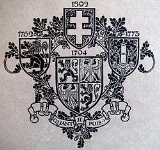
Colleges of St Omer, Bruges and Liège
Encyclopedia
The Colleges of St Omer, Bruges and Liège were successive expatriate institutions for the Catholic
education of English students and were run by the Jesuits.
Initially founded in 1593 by Father Robert Parsons SJ as the College of Saint-Omer
in Artois
, France
(then part of the Spanish Netherlands), the school was forced to relocate twice due to the suppression of the Jesuit order, first to Bruges
in 1762 and then Liège in 1773, before migrating a third and final time to Stonyhurst
in England
where it became Stonyhurst College
in 1794.
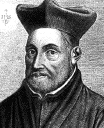 During the reign of Elizabeth I
During the reign of Elizabeth I
religious education for Catholics was subject to penal legislation in England
. The English Catholic church had created several colleges in continental Europe
to make up for this, at Douai
, Rome
, and Valladolid
, but these primarily addressed the training of priests. Especially the English College, Douai
was associated with the faculty of theology of the University of Douai
. Father Robert Parsons (1546–1610), had been instrumental in founding the English College, Valladolid
, but recognized a need for a school for laymen. Saint-Omer was chosen as a site conveniently close to England (it is 24 miles from Calais
), and ruled by Spain
as part of Flanders
. It was also near the University of Douai
, wherein scholars have been editing and publishing the Douay-Rheims Bible .
The college was originally founded in 1593 as the English Jesuit College at St Omer in Flanders
(although an alternative tradition dates the founding to 1592). In 1599 it gained the direct patronage of King Philip
. After an initial period of growth and prosperity, the unrest caused by the English Civil War
caused the number of students to drop as low as 24 in 1645. As stability returned to the government, the school's effectiveness was also restored.
.
The college enjoyed its greatest period of prosperity, which extended from around 1720 to 1762. During a period when formal sworn affiliation with the Church of England
was required to attend Oxford
and Cambridge
, it provided advanced education for several generations of English Catholics. Since the colleges founded in the American colonies were also church affiliated, Catholic families there sent young men to St. Omer for education.
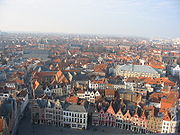 In 1762, the Jesuits were formally expelled from France, beginning the college's decline and eventual end. The expulsion split the college. The Jesuit faculty and many of the students fled to Belgium
In 1762, the Jesuits were formally expelled from France, beginning the college's decline and eventual end. The expulsion split the college. The Jesuit faculty and many of the students fled to Belgium
, moving first to Bruges, and then operating under the protection of the Bishop of Liège from 1773. King Louis XV
continued the college at St. Omer, under the direction of secular clergy. When the Jesuit order was suppressed everywhere in 1773, this dual system ended, but the college never regained its prominence.
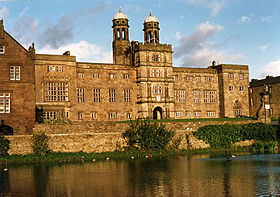 In 1793, the French Revolution
In 1793, the French Revolution
and the United Kingdom declaration of war to France ended the Saint Omer college. The English faculty and students were imprisoned until February 1795. English penal laws and related discrimination had changed regarding Catholic education, so when released, some of the staff and most of the then about 100 students went to England, in order to avoid war on the European continent. A former student, Thomas Weld
, donated a mansion and grounds at Stonyhurst, in Lancashire
. The modern school, Stonyhurst College
continues to this day as a direct lineal descendant of the College of St. Omer.
The Lycée Alexandre Ribot
now stands on the site of the former college in Saint Omer.
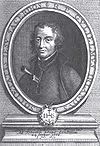 Alumni include: three Saints, twelve Beati
Alumni include: three Saints, twelve Beati
, and twenty-two martyrs.
, the last President of Liège was also the first President of Stonyhurst College
and re-established the Society of Jesus
in Britain in 1803 at Stonyhurst
.
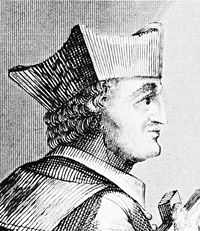 style="font-size:100%;"
style="font-size:100%;"
St Omer (1593–1762)
Bruges (1762–1773)
Liège (1773–1794)
Roman Catholic Church
The Catholic Church, also known as the Roman Catholic Church, is the world's largest Christian church, with over a billion members. Led by the Pope, it defines its mission as spreading the gospel of Jesus Christ, administering the sacraments and exercising charity...
education of English students and were run by the Jesuits.
Initially founded in 1593 by Father Robert Parsons SJ as the College of Saint-Omer
Saint-Omer
Saint-Omer , a commune and sub-prefecture of the Pas-de-Calais department west-northwest of Lille on the railway to Calais. The town is named after Saint Audomar, who brought Christianity to the area....
in Artois
Artois
Artois is a former province of northern France. Its territory has an area of around 4000 km² and a population of about one million. Its principal cities are Arras , Saint-Omer, Lens and Béthune.-Location:...
, France
France
The French Republic , The French Republic , The French Republic , (commonly known as France , is a unitary semi-presidential republic in Western Europe with several overseas territories and islands located on other continents and in the Indian, Pacific, and Atlantic oceans. Metropolitan France...
(then part of the Spanish Netherlands), the school was forced to relocate twice due to the suppression of the Jesuit order, first to Bruges
Bruges
Bruges is the capital and largest city of the province of West Flanders in the Flemish Region of Belgium. It is located in the northwest of the country....
in 1762 and then Liège in 1773, before migrating a third and final time to Stonyhurst
Stonyhurst
Stonyhurst is the name of a rural estate owned by the Society of Jesus near Clitheroe in Lancashire, England. It is dominated by Stonyhurst College, its preparatory school Stonyhurst Saint Mary's Hall and the parish Church of St Peter's.-The Estate:...
in England
England
England is a country that is part of the United Kingdom. It shares land borders with Scotland to the north and Wales to the west; the Irish Sea is to the north west, the Celtic Sea to the south west, with the North Sea to the east and the English Channel to the south separating it from continental...
where it became Stonyhurst College
Stonyhurst College
Stonyhurst College is a Roman Catholic independent school, adhering to the Jesuit tradition. It is located on the Stonyhurst Estate near the village of Hurst Green in the Ribble Valley area of Lancashire, England, and occupies a Grade I listed building...
in 1794.
Founding

Elizabeth I of England
Elizabeth I was queen regnant of England and Ireland from 17 November 1558 until her death. Sometimes called The Virgin Queen, Gloriana, or Good Queen Bess, Elizabeth was the fifth and last monarch of the Tudor dynasty...
religious education for Catholics was subject to penal legislation in England
England
England is a country that is part of the United Kingdom. It shares land borders with Scotland to the north and Wales to the west; the Irish Sea is to the north west, the Celtic Sea to the south west, with the North Sea to the east and the English Channel to the south separating it from continental...
. The English Catholic church had created several colleges in continental Europe
Europe
Europe is, by convention, one of the world's seven continents. Comprising the westernmost peninsula of Eurasia, Europe is generally 'divided' from Asia to its east by the watershed divides of the Ural and Caucasus Mountains, the Ural River, the Caspian and Black Seas, and the waterways connecting...
to make up for this, at Douai
English College, Douai
The English College, Douai was a Catholic seminary associated with the University of Douai . It was established in about 1561, and was suppressed in 1793...
, Rome
Rome
Rome is the capital of Italy and the country's largest and most populated city and comune, with over 2.7 million residents in . The city is located in the central-western portion of the Italian Peninsula, on the Tiber River within the Lazio region of Italy.Rome's history spans two and a half...
, and Valladolid
Valladolid
Valladolid is a historic city and municipality in north-central Spain, situated at the confluence of the Pisuerga and Esgueva rivers, and located within three wine-making regions: Ribera del Duero, Rueda and Cigales...
, but these primarily addressed the training of priests. Especially the English College, Douai
English College, Douai
The English College, Douai was a Catholic seminary associated with the University of Douai . It was established in about 1561, and was suppressed in 1793...
was associated with the faculty of theology of the University of Douai
University of Douai
The University of Douai is a former university in Douai, France. With a Middle Ages heritage of scholar activities in Douai, the university was established in 1559 and lectures started in 1562. It closed from 1795 to 1808...
. Father Robert Parsons (1546–1610), had been instrumental in founding the English College, Valladolid
English College, Valladolid
The Royal English and Welsh College, Valladolid, under the patronage of St Alban, was founded in 1589 during the protestant reformation for the training of Catholic priests for the English and Welsh Mission....
, but recognized a need for a school for laymen. Saint-Omer was chosen as a site conveniently close to England (it is 24 miles from Calais
Calais
Calais is a town in Northern France in the department of Pas-de-Calais, of which it is a sub-prefecture. Although Calais is by far the largest city in Pas-de-Calais, the department's capital is its third-largest city of Arras....
), and ruled by Spain
Spain
Spain , officially the Kingdom of Spain languages]] under the European Charter for Regional or Minority Languages. In each of these, Spain's official name is as follows:;;;;;;), is a country and member state of the European Union located in southwestern Europe on the Iberian Peninsula...
as part of Flanders
Flanders
Flanders is the community of the Flemings but also one of the institutions in Belgium, and a geographical region located in parts of present-day Belgium, France and the Netherlands. "Flanders" can also refer to the northern part of Belgium that contains Brussels, Bruges, Ghent and Antwerp...
. It was also near the University of Douai
University of Douai
The University of Douai is a former university in Douai, France. With a Middle Ages heritage of scholar activities in Douai, the university was established in 1559 and lectures started in 1562. It closed from 1795 to 1808...
, wherein scholars have been editing and publishing the Douay-Rheims Bible .
The college was originally founded in 1593 as the English Jesuit College at St Omer in Flanders
Flanders
Flanders is the community of the Flemings but also one of the institutions in Belgium, and a geographical region located in parts of present-day Belgium, France and the Netherlands. "Flanders" can also refer to the northern part of Belgium that contains Brussels, Bruges, Ghent and Antwerp...
(although an alternative tradition dates the founding to 1592). In 1599 it gained the direct patronage of King Philip
Philip III of Spain
Philip III , also known as Philip the Pious, was the King of Spain and King of Portugal and the Algarves, where he ruled as Philip II , from 1598 until his death...
. After an initial period of growth and prosperity, the unrest caused by the English Civil War
English Civil War
The English Civil War was a series of armed conflicts and political machinations between Parliamentarians and Royalists...
caused the number of students to drop as low as 24 in 1645. As stability returned to the government, the school's effectiveness was also restored.
French rule
St. Omer and much of the province of Artois were formally ceded back to France in 1658. But the Catholic French monarchy was as friendly to the school as the Spanish crown had been before. As the eighteenth century began, two fires ravaged the town and the university. But each time it was rebuilt, and even expanded. Buildings from this second reconstruction in the 1720s remained in use into the twentieth century, serving as a military hospital in World War IWorld War I
World War I , which was predominantly called the World War or the Great War from its occurrence until 1939, and the First World War or World War I thereafter, was a major war centred in Europe that began on 28 July 1914 and lasted until 11 November 1918...
.
The college enjoyed its greatest period of prosperity, which extended from around 1720 to 1762. During a period when formal sworn affiliation with the Church of England
Church of England
The Church of England is the officially established Christian church in England and the Mother Church of the worldwide Anglican Communion. The church considers itself within the tradition of Western Christianity and dates its formal establishment principally to the mission to England by St...
was required to attend Oxford
University of Oxford
The University of Oxford is a university located in Oxford, United Kingdom. It is the second-oldest surviving university in the world and the oldest in the English-speaking world. Although its exact date of foundation is unclear, there is evidence of teaching as far back as 1096...
and Cambridge
University of Cambridge
The University of Cambridge is a public research university located in Cambridge, United Kingdom. It is the second-oldest university in both the United Kingdom and the English-speaking world , and the seventh-oldest globally...
, it provided advanced education for several generations of English Catholics. Since the colleges founded in the American colonies were also church affiliated, Catholic families there sent young men to St. Omer for education.
Bruges, Liège, Stonyhurst

Belgium
Belgium , officially the Kingdom of Belgium, is a federal state in Western Europe. It is a founding member of the European Union and hosts the EU's headquarters, and those of several other major international organisations such as NATO.Belgium is also a member of, or affiliated to, many...
, moving first to Bruges, and then operating under the protection of the Bishop of Liège from 1773. King Louis XV
Louis XV of France
Louis XV was a Bourbon monarch who ruled as King of France and of Navarre from 1 September 1715 until his death. He succeeded his great-grandfather at the age of five, his first cousin Philippe II, Duke of Orléans, served as Regent of the kingdom until Louis's majority in 1723...
continued the college at St. Omer, under the direction of secular clergy. When the Jesuit order was suppressed everywhere in 1773, this dual system ended, but the college never regained its prominence.

French Revolution
The French Revolution , sometimes distinguished as the 'Great French Revolution' , was a period of radical social and political upheaval in France and Europe. The absolute monarchy that had ruled France for centuries collapsed in three years...
and the United Kingdom declaration of war to France ended the Saint Omer college. The English faculty and students were imprisoned until February 1795. English penal laws and related discrimination had changed regarding Catholic education, so when released, some of the staff and most of the then about 100 students went to England, in order to avoid war on the European continent. A former student, Thomas Weld
Thomas Weld
Thomas Weld , who came to Boston on 5 June 1632 on the "William and Francis", was a Puritan emigrant from England and the first minister of the First Church in Roxbury, Massachusetts from 1632 to 1641.-Biography:...
, donated a mansion and grounds at Stonyhurst, in Lancashire
Lancashire
Lancashire is a non-metropolitan county of historic origin in the North West of England. It takes its name from the city of Lancaster, and is sometimes known as the County of Lancaster. Although Lancaster is still considered to be the county town, Lancashire County Council is based in Preston...
. The modern school, Stonyhurst College
Stonyhurst College
Stonyhurst College is a Roman Catholic independent school, adhering to the Jesuit tradition. It is located on the Stonyhurst Estate near the village of Hurst Green in the Ribble Valley area of Lancashire, England, and occupies a Grade I listed building...
continues to this day as a direct lineal descendant of the College of St. Omer.
The Lycée Alexandre Ribot
Lycée Alexandre Ribot
The Lycée Alexandre Ribot is a school located at 42 rue Gambetta, in the town of Saint-Omer , France. Founded as a Walloon Jesuit college in 1565 , it has been a lycée since 1848...
now stands on the site of the former college in Saint Omer.
Notable alumni

Beatification
Beatification is a recognition accorded by the Catholic Church of a dead person's entrance into Heaven and capacity to intercede on behalf of individuals who pray in his or her name . Beatification is the third of the four steps in the canonization process...
, and twenty-two martyrs.
- St Philip EvansPhilip Evans and John LloydSaints Philip Evans and John Lloyd were Welsh Roman Catholic priests, who died for their faith. They are both among the Forty Martyrs of England and Wales.-Father Philip Evans:...
SJ, executed at Tyburn in 1679. - St Thomas GarnetThomas GarnetSaint Thomas Garnet was a Jesuit priest. He is the protomartyr of Saint Omer and therefore of Stonyhurst College. He was executed at Tyburn and is one of the Forty Martyrs of England and Wales.-Thomas Garnet's family:Thomas Garnet was born into a prominent family...
SJ, protomartyr of St Omers, one of the Forty Martyrs of England and Wales, executed at Tyburn in 1608. - St John PlessingtonJohn PlessingtonSt John Plessington , also known as John Plesington, William Scarisbrick and William Pleasington, is one of the Roman Catholic Forty Martyrs of England and Wales....
, executed at Chester in 1679. - Archbishop John CarrollJohn Carroll (bishop)John Carroll, was the first Roman Catholic bishop and archbishop in the United States — serving as the ordinary of the Archdiocese of Baltimore. He is also known as the founder of Georgetown University, the oldest Catholic university in the United States, and St...
, SJ, first Archbishop of Baltimore and founder of Georgetown UniversityGeorgetown UniversityGeorgetown University is a private, Jesuit, research university whose main campus is in the Georgetown neighborhood of Washington, D.C. Founded in 1789, it is the oldest Catholic university in the United States...
in Washington, D.C.Washington, D.C.Washington, D.C., formally the District of Columbia and commonly referred to as Washington, "the District", or simply D.C., is the capital of the United States. On July 16, 1790, the United States Congress approved the creation of a permanent national capital as permitted by the U.S. Constitution....
, America's oldest Catholic university. - Charles CarrollCharles Carroll of CarrolltonCharles Carroll of Carrollton was a wealthy Maryland planter and an early advocate of independence from Great Britain. He served as a delegate to the Continental Congress and later as United States Senator for Maryland...
, Maryland delegate, signer of the Declaration of IndependenceDeclaration of independenceA declaration of independence is an assertion of the independence of an aspiring state or states. Such places are usually declared from part or all of the territory of another nation or failed nation, or are breakaway territories from within the larger state... - Daniel CarrollDaniel CarrollDaniel Carroll was a politician and one of the Founding Fathers of the United States. He was a prominent member of one of the United States' great colonial Catholic families, whose members included his younger brother Archbishop John Carroll, the first Catholic bishop in the United States and...
, brother of John and cousin of Charles, one of only five men to sign both the Articles of ConfederationArticles of ConfederationThe Articles of Confederation, formally the Articles of Confederation and Perpetual Union, was an agreement among the 13 founding states that legally established the United States of America as a confederation of sovereign states and served as its first constitution...
and the United States ConstitutionUnited States ConstitutionThe Constitution of the United States is the supreme law of the United States of America. It is the framework for the organization of the United States government and for the relationship of the federal government with the states, citizens, and all people within the United States.The first three...
. - William Ireland
- Arthur MurphyArthur MurphyArthur Murphy , also known by the pseudonym Charles Ranger, was an Irish writer.-Biography:He was born at Cloonyquin, County Roscommon, Ireland, the son of Richard Murphy and Jane French....
barrister, journalist, actor, biographer, translator and playwright
Rectors and Superiors
Below is a list of those who led the College from its foundation until the move to England. Marmaduke StoneMarmaduke Stone
Marmaduke Stone was an English Jesuit, in a position of leadership when the Order was dissolved.-Life:Stone was born in Draycott and educated at St. Omers, sharing in its exodus to Bruges, 10-17 August, 1762. He entered the Society of Jesus in 1767, later became a master at the Liège Academy...
, the last President of Liège was also the first President of Stonyhurst College
Stonyhurst College
Stonyhurst College is a Roman Catholic independent school, adhering to the Jesuit tradition. It is located on the Stonyhurst Estate near the village of Hurst Green in the Ribble Valley area of Lancashire, England, and occupies a Grade I listed building...
and re-established the Society of Jesus
Society of Jesus
The Society of Jesus is a Catholic male religious order that follows the teachings of the Catholic Church. The members are called Jesuits, and are also known colloquially as "God's Army" and as "The Company," these being references to founder Ignatius of Loyola's military background and a...
in Britain in 1803 at Stonyhurst
Stonyhurst
Stonyhurst is the name of a rural estate owned by the Society of Jesus near Clitheroe in Lancashire, England. It is dominated by Stonyhurst College, its preparatory school Stonyhurst Saint Mary's Hall and the parish Church of St Peter's.-The Estate:...
.

St Omer (1593–1762)
- Superior
- William Flack SJ (1593-1594)
- Rectors
- Jean Foucart SJ (1594-1601)
- Gilles Schoondonck SJ (1601-1617)
- Philippe Dentiers SJ (1617-1621)
- William Baldwin SJ (1621-1632)
- Thomas Worsley SJ (1632-1637)
- Thomas Port SJ (1637-1646)
- Edward Courtney SJ (1646-1649)
- Henry More SJ (1649-1660)
- Richard Barton SJ (1660-1669)
- Thomas Cary SJ (1669-1672)
- Richard AshbyRichard AshbyRichard 'Chufty' Ashby is a professional poker player from London. He was given the name 'Chufty' by his friends at University, due to Richard's frequency of using the term "chuffed"....
SJ (1672-1679) - Thomas Stapleton SJ (1679-1683)
- John Warner SJ (1683-1688)
- Michael Constable SJ (1688-1693)
- Edward PetreEdward PetreSir Edward Petre, 3rd baronet SJ was an English Jesuit who became a close adviser to King James II and was appointed a privy councillor.-Early life:...
SJ (1693-1697) - William Walton SJ (1697-1701)
- Henry Humberston SJ (1701-1705)
- Edward Slaughter SJ (1705-1709)
- Richard Plowden SJ (1709-1712)
- Louis Sabran SJ (1712-1715)
- Francis Powell SJ (1715-1720)
- William Darell SJ (1720-1721)
- John Turberville SJ (1721-1722)
- James Gooden SJ (1722-1725)
- Richard Plowden SJ (1725-1728)
- Richard Hyde SJ (1728-1731)
- Thomas Eccleston SJ (1731-1737)
- Marmaduke Constable SJ (1737-1739)
- Percy Plowden SJ (1739-1742)
- Richard Hyde SJ (1742-1745)
- Charles Wells SJ (1745-1748)
- Nathaniel Elliott SJ (1748-1752)
- John Darell SJ (1752-1759)
- Francis Scarisbrick SJ (1759-1762)
Bruges (1762–1773)
- Nathaniel Elliott SJ (1762-1766)
- Thomas Lawson SJ (1766-1769)
- Thomas Stanley SJ (1769-1772)
- Thomas Angier SJ (1772-1773)
Liège (1773–1794)
- Director
- John Howard SJ (1773-1783)
- Presidents
- William Strickland SJ (1783-1790)
- Marmaduke StoneMarmaduke StoneMarmaduke Stone was an English Jesuit, in a position of leadership when the Order was dissolved.-Life:Stone was born in Draycott and educated at St. Omers, sharing in its exodus to Bruges, 10-17 August, 1762. He entered the Society of Jesus in 1767, later became a master at the Liège Academy...
SJ (1790-1794)

